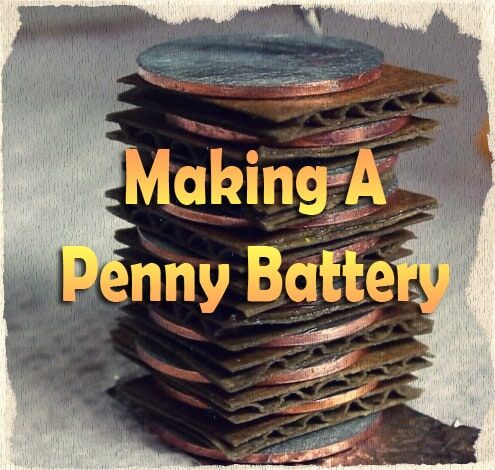
Making a penny battery is not a practical project. However, it is a practical bit of knowledge to keep in the back of your head.
I used this knowledge to build a larger battery in a mason jar. The same type of science is what makes Edison Batteries work.
What we are making today is voltaic piles
We will build them out of pennies zinc coated washers and bits of paper.
Each cell of a penny, a washer, and a small square of wet paper produces up to about 0.8 volts, and you can stack multiple cells to create higher voltages.
I have done this with after school groups with kids in kindergarten to fifth grade (with various depth of explanation) and it is very useful to introduce chemistry and the fun of DIY.
Some people use 1982-present pennies that have the copper coating sanded off as the zinc, but since it is illegal to deface US currency I use zinc washers (well… to be honest I use zinc washers because it is MUCH easier).
If you want to do anything slightly resembling useful, you will need at least 5 cells – It would take a pile about the size of your living room and 5ft tall to actually run your home, so lighting up a led or sounding a small piezo electric buzzer are about the limits of this tech
Rip up a piece of thin cardboard (I use business cards, but something like a cereal box would probably work) into squares the size of your pennies.
Soak them in vinegar or lemon juice as this is a wet cell (which means as the cardboard dries the cell stops producing electricity)
Layer in the following sequence:
- Penny
- Soaked Paper
- Zinc
Start another cell by stacking a new penny right on top of the copper and then keep this up until you have enough light your led or buzz your buzzer.
I have found more than 5 cells starts to get unwieldy, and trying to use electric tape to hold it together has stymied the video for some time – maybe using a plastic coin roll, or a length of plastic pipe may make this project easier.
A cell like this will only work about 6 hours or so, but like the chlorine battery show potential. If I can every get around to learning to electroplate I will show how to make an Edison nickel iron battery that can be made cheaply and can actually allow you to make batteries out of five gallon buckets that can do usable work.
